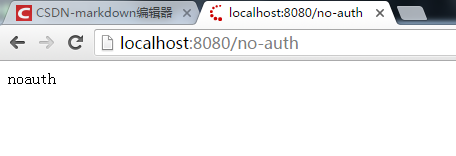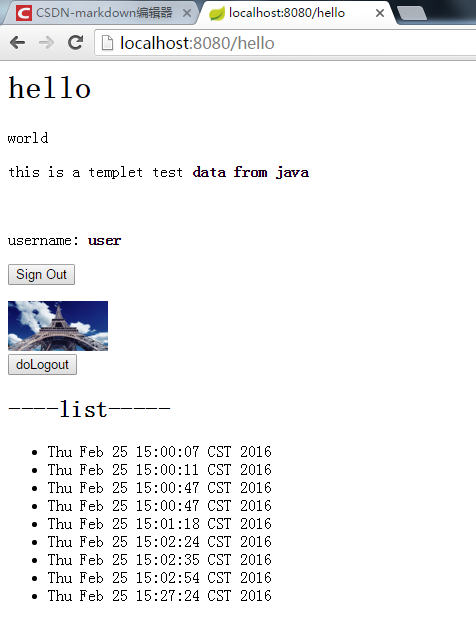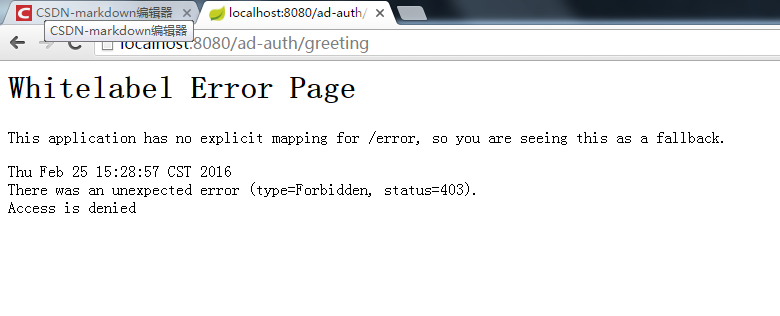您好,登錄后才能下訂單哦!
您好,登錄后才能下訂單哦!
最終效果
1、實現頁面訪問權限限制
2、用戶角色區分,并按照角色區分頁面權限
3、實現在數據庫中存儲用戶信息以及角色信息
4、自定義驗證代碼
效果如下:
1、免驗證頁面

2、登陸頁面
在用戶未登錄時,訪問任意有權限要求的頁面都會自動跳轉到登陸頁面。

3、需登陸才能查看的頁面
用戶登陸后,可以正常訪問頁面資源,同時可以正確顯示用戶登錄名:

4、用戶有角色區分,可以指定部分頁面只允許有相應用戶角色的人使用
4.1、只有ADMIN覺得用戶才能查看的頁面(權限不足)

4.2、只有ADMIN覺得用戶才能查看的頁面(權限滿足)

以下具體說明實現步驟。
代碼實現
MAVEN引入依賴
在pom.xml中引入spring security依賴
<dependency>
<groupId>org.springframework.boot</groupId>
<artifactId>spring-boot-starter-security</artifactId>
</dependency>
配置Spring Security
在Spring中,配置和使用Spring Security,在不需要修改太多流程細節的情況下僅需聲明好攔截規則,同時自定義驗證過程中的主要實現接口(用戶信息UserDetails,用戶信息獲取服務UserDetailsService,驗證工具AuthenticationProvider)即可。其余的流程將由Spring自動接管,非常方便。
啟動配置
在項目包下添加WebSecurityConfigurerAdapter 的具體實現類,實現Spring Security的啟動配置
代碼如下:
@Configurable
@EnableWebSecurity
@EnableGlobalMethodSecurity(prePostEnabled = true)//允許進入頁面方法前檢驗
public class WebSecurityConfig extends WebSecurityConfigurerAdapter {
@Autowired
private MyAuthenticationProvider provider;//自定義驗證
@Autowired
private UserDetailsService userDetailsService;//自定義用戶服務
@Autowired
public void configAuthentication(AuthenticationManagerBuilder auth) throws Exception{
}
@Override
protected void configure(HttpSecurity http) throws Exception {
http.authorizeRequests()
.antMatchers(StaticParams.PATHREGX.NOAUTH,
StaticParams.PATHREGX.CSS,StaticParams.PATHREGX.JS,StaticParams.PATHREGX.IMG).permitAll()//無需訪問權限
.antMatchers(StaticParams.PATHREGX.AUTHADMIN).hasAuthority(StaticParams.USERROLE.ROLE_ADMIN)//admin角色訪問權限
.antMatchers(StaticParams.PATHREGX.AUTHUSER).hasAuthority(StaticParams.USERROLE.ROLE_USER)//user角色訪問權限
.anyRequest()//all others request authentication
.authenticated()
.and()
.formLogin().loginPage("/login").permitAll()
.and()
.logout().permitAll();
}
@Autowired
public void configureGlobal(AuthenticationManagerBuilder auth) throws Exception {
//將驗證過程交給自定義驗證工具
auth.authenticationProvider(provider);
}
URL攔截配置
URL攔截配置可以在上一小節的WebSecurityConfig 中配置,但是此方法適用于大方向上的配置,具體的特殊路徑也可以在@Controller的注解中具體配置。
如下:
@ResponseBody
@PreAuthorize("hasAuthority('"+StaticParams.USERROLE.ROLE_ADMIN+"')")//這里可以指定特定角色的用戶訪問權限
@RequestMapping(value = "adminrequire", method = RequestMethod.GET)
public String adminrequire(){
return "HELLO from web but you should be admin";
}
用戶、角色表
在本文例子中用戶和角色可以有一對多的關系因此可以將用戶和角色分成兩張表。有些例子將用戶和權限寫在同一張表上也是可以的。
/*用戶表*/
@Entity
@Table(name = "user")
public class SystemUser {
@Id
@Column(name = "id")
@GeneratedValue(strategy = GenerationType.AUTO)
private Long id;
private String userName;
private String password;
public SystemUser(){}
public SystemUser(SystemUser user){
this.userName = user.getUserName();
this.password = user.getPassword();
this.id = user.getId();
}
public Long getId() {
return id;
}
public void setId(Long id) {
this.id = id;
}
public String getUserName() {
return userName;
}
public void setUserName(String userName) {
this.userName = userName;
}
public String getPassword() {
return password;
}
public void setPassword(String password) {
this.password = password;
}
}
/*角色表*/
@Entity
@Table(name = "user_role")
public class UserRole {
@Id
@Column(name = "id")
@GeneratedValue(strategy = GenerationType.AUTO)
private Long id;
private String role;
private Long userId;
public Long getId() {
return id;
}
public void setId(Long id) {
this.id = id;
}
public String getRole() {
return role;
}
public void setRole(String role) {
this.role = role;
}
public Long getUserId() {
return userId;
}
public void setUserId(Long userId) {
this.userId = userId;
}
}
自定義驗證
在Spring Boot的Spring Security的教程中默認的用戶名、密碼、權限是在代碼中指定的
@Autowired
public void configureGlobal(AuthenticationManagerBuilder auth) throws Exception {
auth
.inMemoryAuthentication()
.withUser("user").password("password").roles("USER");
}
這顯然是不符合應用需求的,所以我們需要提供自定義的AuthenticationProvider,并在上邊代碼中替換即可。在此之前,我們應該重寫獲取用戶User和權限的方法。通過查詢相關資料和API,方法提供如下:
自定義UserDetails
UserDetails代表了Spring Security的用戶認證實體,帶有用戶名、密碼、權限列表、過期特性等性質,可以自己聲明類實現UserDetails接口,如果不想自己聲明,也可以用SpringSecurity的默認實現org.springframework.security.core.userdetails.User 本文例子中采用自定義類:
public class MyUserDetails extends SystemUser implements UserDetails{
private List<UserRole> roles;
public MyUserDetails(SystemUser user, List<UserRole> roles){
super(user);
this.roles = roles;
}
@Override
public Collection<? extends GrantedAuthority> getAuthorities() {
if(roles == null || roles.size() <1){
return AuthorityUtils.commaSeparatedStringToAuthorityList("");
}
StringBuilder commaBuilder = new StringBuilder();
for(UserRole role : roles){
commaBuilder.append(role.getRole()).append(",");
}
String authorities = commaBuilder.substring(0,commaBuilder.length()-1);
return AuthorityUtils.commaSeparatedStringToAuthorityList(authorities);
}
@Override
public String getPassword() {
return super.getPassword();
}
@Override
public String getUsername() {
return super.getUserName();
}
@Override
public boolean isAccountNonExpired() {
return true;
}
@Override
public boolean isAccountNonLocked() {
return true;
}
@Override
public boolean isCredentialsNonExpired() {
return true;
}
@Override
public boolean isEnabled() {
return true;
}
}
自定義UserDetailsService
UserDetailsService提供了獲取UserDetails的方式,只要實現UserDetailsService接口即可,最終生成用戶和權限共同組成的UserDetails,在這里就可以實現從自定義的數據源中獲取用戶信息了:
@Service("MyUserDetailsImpl")
public class MyUserDetailsService implements UserDetailsService {
@Resource(name = "SystemUserServiceImpl")
private SystemUserService systemUserService;
@Resource(name = "UserRoleServiceImpl")
private UserRoleService userRoleService;
@Override
public UserDetails loadUserByUsername(String userName) throws UsernameNotFoundException {
SystemUser user;
try {
user = systemUserService.findByName(userName);
} catch (Exception e) {
throw new UsernameNotFoundException("user select fail");
}
if(user == null){
throw new UsernameNotFoundException("no user found");
} else {
try {
List<UserRole> roles = userRoleService.getRoleByUser(user);
return new MyUserDetails(user, roles);
} catch (Exception e) {
throw new UsernameNotFoundException("user role select fail");
}
}
}
}
自定義AuthenticationProvider
AuthenticationProvider 提供用戶UserDetails的具體驗證方式,在這里可以自定義用戶密碼的加密、驗證方式等等。因為博文主要講的是如何引入Spring Security和如何自定義驗證代碼,所以這里為了簡便,我直接采用明文比較方式:
@Component
public class MyAuthenticationProvider implements AuthenticationProvider {
@Autowired
private MyUserDetailsService userService;
/**
* 自定義驗證方式
*/
@Override
public Authentication authenticate(Authentication authentication) throws AuthenticationException {
String username = authentication.getName();
String password = (String) authentication.getCredentials();
MyUserDetails user = (MyUserDetails) userService.loadUserByUsername(username);
if(user == null){
throw new BadCredentialsException("Username not found.");
}
//加密過程在這里體現
if (!password.equals(user.getPassword())) {
throw new BadCredentialsException("Wrong password.");
}
Collection<? extends GrantedAuthority> authorities = user.getAuthorities();
return new UsernamePasswordAuthenticationToken(user, password, authorities);
}
@Override
public boolean supports(Class<?> arg0) {
return true;
}
}
以上就是本文的全部內容,希望對大家的學習有所幫助,也希望大家多多支持億速云。
免責聲明:本站發布的內容(圖片、視頻和文字)以原創、轉載和分享為主,文章觀點不代表本網站立場,如果涉及侵權請聯系站長郵箱:is@yisu.com進行舉報,并提供相關證據,一經查實,將立刻刪除涉嫌侵權內容。